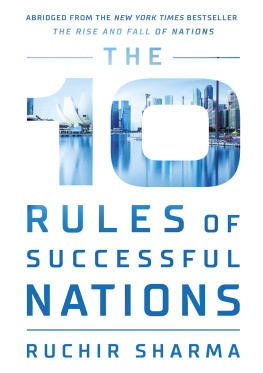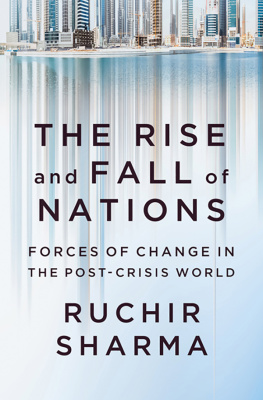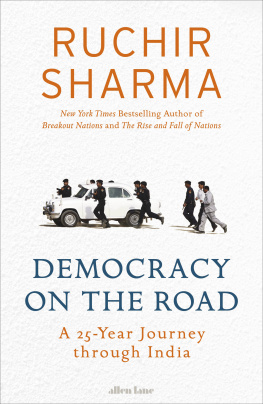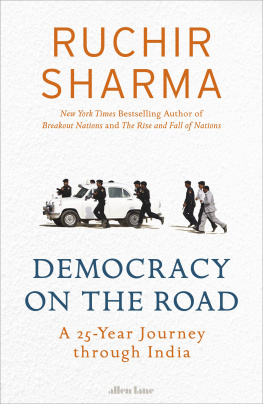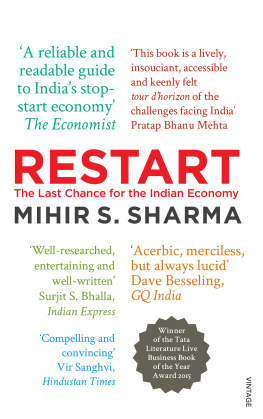Ruchir Sharma - The 10 Rules of Successful Nations
Here you can read online Ruchir Sharma - The 10 Rules of Successful Nations full text of the book (entire story) in english for free. Download pdf and epub, get meaning, cover and reviews about this ebook. year: 2020, publisher: W. W. Norton & Company, genre: Politics. Description of the work, (preface) as well as reviews are available. Best literature library LitArk.com created for fans of good reading and offers a wide selection of genres:
Romance novel
Science fiction
Adventure
Detective
Science
History
Home and family
Prose
Art
Politics
Computer
Non-fiction
Religion
Business
Children
Humor
Choose a favorite category and find really read worthwhile books. Enjoy immersion in the world of imagination, feel the emotions of the characters or learn something new for yourself, make an fascinating discovery.
- Book:The 10 Rules of Successful Nations
- Author:
- Publisher:W. W. Norton & Company
- Genre:
- Year:2020
- Rating:3 / 5
- Favourites:Add to favourites
- Your mark:
- 60
- 1
- 2
- 3
- 4
- 5
The 10 Rules of Successful Nations: summary, description and annotation
We offer to read an annotation, description, summary or preface (depends on what the author of the book "The 10 Rules of Successful Nations" wrote himself). If you haven't found the necessary information about the book — write in the comments, we will try to find it.
The 10 Rules of Successful Nations — read online for free the complete book (whole text) full work
Below is the text of the book, divided by pages. System saving the place of the last page read, allows you to conveniently read the book "The 10 Rules of Successful Nations" online for free, without having to search again every time where you left off. Put a bookmark, and you can go to the page where you finished reading at any time.
Font size:
Interval:
Bookmark:

Also by Ruchir Sharma
The Rise and Fall of Nations:
Forces of Change in the Post-Crisis World
Breakout Nations:
In Pursuit of the Next Economic Miracles
 THE
THE 
RULES OF
SUCCESSFUL
NATIONS
RUCHIR SHARMA

SUCCESSFUL NATIONS
E conomists have failed to predict every US recession since records began, including the Great Recession that rattled the world in 2008. They are under attack even within their own ranks for being too academictoo focused on elegant mathematical models that pretend humans always act rationally, or on data that is updated too infrequently to foretell big economic shifts.
Everyone knows that forecasting is a mugs game, but also necessary and unavoidable. Politicians, technocrats, businesspeople, and investors all have a huge stake in predicting the economic rise and fall of nations, since they cant begin to formulate plans or policies without making an educated estimate as to what is coming next. Getting it right can help billions of people; the costs of getting it wrong are equally large.
This book, culled from my quarter century in the game, outlines ten rules for spotting whether a country is on the rise, on the decline, or just muddling through. Together, the rules work as a system for spotting change.
A few basic principles underlie all the rules. The first is to recognize the impermanence of economic trends and the regular rhythms of change. Recent crises are just the latest reminder that the normal condition of the world is impermanencean environment prone to booms, busts, and protests.
In the 1960s the fast-growing Philippine economy was being feted as the future of Asia, and that buzz helped Manila win the right to host the headquarters of the Asian Development Bank. By the next decade, under the dictatorship of Ferdinand Marcos, growth was stalling, but the ADB was in Manila for good. In the 1970s, similar exercises in extrapolation led some American scholars and intelligence analysts to predict that the Soviet economy was destined to become the largest in the world. Instead, it collapsed at the end of the 1980s.
Hard experience did not prevent a new outburst of hype in the first decade of the twenty-first century, when global forceseasy money pouring out of Western banks, spiking prices of commodities, and soaring global tradedoubled the growth rate of emerging nations. By 2007, the number of economies expanding faster than 5 percent had reached 100, or five times the postwar normbut forecasters assumed this freak event was a lasting condition. They figured that if the hot economies stayed hot, the average incomes of many emerging nations would soon catch up to, or converge with, those of rich nations. Envisioning a world without poor countries was about as plausible as forecasting a world without poor people, but few questioned these forecasts.
Marketers had started calling Brazil, Russia, India, and China the BRICs to capture the idea that these emerging giants were a solid bet to dominate the global economy. They assumed Chinas rise would lift up countries like Russia and Brazil, which had been thriving mainly by exporting oil and other commodities to the Chinese. Ever-growing demand from China would drive a super cycle of rising commodity prices and growing wealth from Moscow to Lagos. At the same time, global trade and capital flows were soaring, and many forecasters thought those forces would help boost incomes in the big emerging markets.
This optimism was derailed by the crisis of 2008. Trade flows slowed. Money flows collapsed. The price of oil and other commodities fell sharply, and by 2014, analysts were spoofing the BRICs as broken, crumbling, and a bloody ridiculous investment concept. As of 2019, Russia and Brazil were growing at 1 percent. India, the one BRIC that looked reasonably solid in 2014, was slowing sharply as well.
The fate of the BRICs is a reminder that it is hard to sustain rapid economic growth. The widespread prosperity of the West after World War II, and across the world after 1980, has blinded many to this fact. Looking back 150 years, researchers at Goldman Sachs found dozens of great stagnations, long slumps that lowered a nations average income, relative to its peers. Of these slumps, 90 lasted at least six years, and 26 spanned more than ten years. These slumps hit countries ranging from Germany in the 1860s and 70s to France in the first decade of the twenty-first century. The longest lasted twenty-three years and struck India starting in 1930. Even before the Industrial Revolution, major regions of Europe and Asia went through phases stretching hundreds of years with virtually no growth.
Writers have lavished attention on the postWorld War II miraclesparticularly Asian nations like Japan, South Korea, and Taiwanthat sustained strong growth for decades and graduated from the developing to the developed ranks. But they are rare exceptions to the rule of impermanence. The long slumps and extended setbacks are more common, and at least as relevant as the postwar miracles to understanding how economies really work. Yet forecasters have continued to assume that boomsfrom China to India and Kenyawill last indefinitely. The impermanence of economic conditions means that one can never extrapolate current trends into the distant future.
Keep the Future Close
One basic goal of this book is to refocus economic conversation on a practical time frame. Trends in globalization have ebbed and flowed since at least the twelfth century, when Genghis Khan secured commerce along the Silk Road, and the cycles of business, technology, and politics that shape economic growth are short, typically about five years. As a result, any forecast that looks beyond the next cycle or twofive to ten yearsis likely to be way off the mark.
Predictions that look 20 to 100 years into the future cannot possibly survive change in the intervening years. New economic competitors can arise, as China did in the early 1980s, or as eastern Europe did in the 1990s. New technology can emerge, as the internet did in the 1990s and as new digital manufacturing techniques like 3-D printing are doing now. When a country like Japan, China, or India grows rapidly for a decade, analysts should be looking not for reasons the streak will continue but for the moment the cycle will turn.
For practical people, forecasting is all about timing. The dogged consistency of permabulls and permabears undermines their credibility, because timing matters. Economists like Nouriel Roubini, who had been predicting a US debt meltdown for many years, were given a lot of credit when it finally came in 2008. But had businesses, policy-makers, and investors built plans around those warnings, they would have missed the global boom before 2008 and all the opportunities that came with it. Practical forecasters focus on dynamic indicators that can reveal critical change at the margin, meaning imminent shifts in the economy that can foretell its basic direction for the next five years. They ignore futurists predicting the coming Asian or African century.
Font size:
Interval:
Bookmark:
Similar books «The 10 Rules of Successful Nations»
Look at similar books to The 10 Rules of Successful Nations. We have selected literature similar in name and meaning in the hope of providing readers with more options to find new, interesting, not yet read works.
Discussion, reviews of the book The 10 Rules of Successful Nations and just readers' own opinions. Leave your comments, write what you think about the work, its meaning or the main characters. Specify what exactly you liked and what you didn't like, and why you think so.

